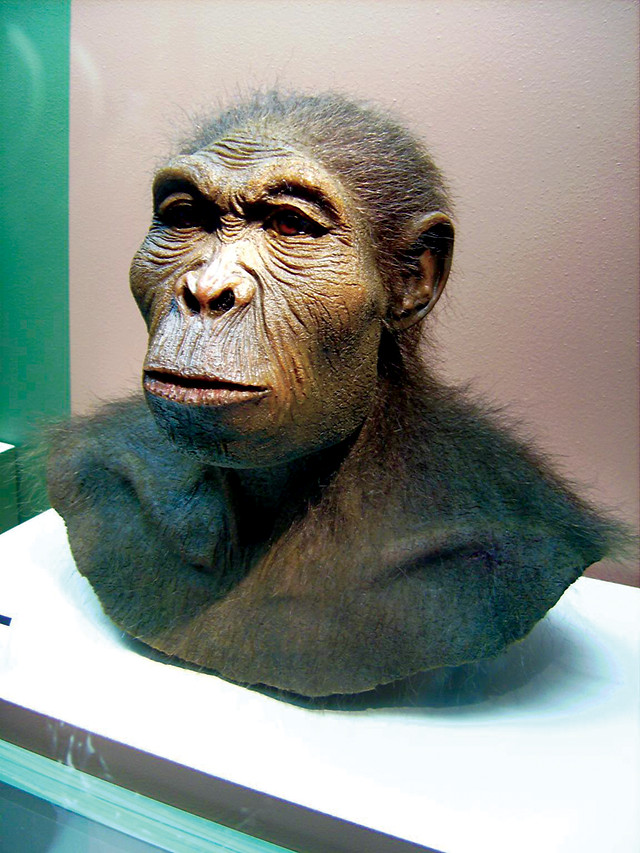
by Mary Caperton Morton Thursday, June 16, 2016

A reconstruction of Homo habilis at the Museum of Archaeology in Herne, Germany. At some point in the diversification of early Homo, facial features that resembled those of humans began to replace the ape-like countenance of early hominins. Credit: Lillyundfreya, CC BY-SA 3.0.
Like modern humans, early hominins walked upright and had opposable thumbs, but their faces were more ape-like, with flattened noses and protruding foreheads. It wasn’t until the evolution of the genus Homo that hominin faces began to look more human — flatter overall but with protruding noses. Along with changes in external appearance came internal changes as well, though these are less well understood as soft-tissue structures preserved in the fossil record are hard to come by. In a new study, researchers comparing both modern human and nonhuman primate nasal cavities offer some clues as to how our respiratory system evolved on the inside to compensate for the changes on the outside.
One important function of the upper respiratory system is “air conditioning,” in which inhaled air is humidified and warmed before it hits the lungs; air that is too dry and cold can damage lung tissue. Humans are “very efficient at conditioning air. If you inhale air that’s minus 18 degrees Celsius, by the time it hits the lungs it will be 34 degrees Celsius, close to core [body] temperature,” says David Elad, a biomedical engineer at Tel Aviv University in Israel who was not involved in the new study.
But humans condition air differently than other primates, says Takeshi Nishimura, a primatologist at Kyoto University in Japan and lead author of the new study, published in PLOS Computational Biology. Nishimura and his colleagues simulated nasal air conditioning in humans and nonhuman primates — specifically chimpanzees and macaques — using computational fluid dynamics models. It’s the first time the technique has been used to study nonhuman primates.
The modeling showed that differences in the internal anatomy of human versus nonhuman primate noses — in the orientation of the nasal vestibule just inside the nostrils, for example — affect how air flows through them. In humans, a vertically oriented vestibule causes an “upward curved airflow,” while a horizontal vestibule in chimpanzees and macaques makes for “straight flow in the nasal cavity,” Nishimura says. Additionally, they found that in the primates, air conditioning occurs partially within the nose itself, but in humans, inhaled air is conditioned in the pharyngeal cavity, which connects the rear of the nasal and oral cavities to the esophagus.
The pharyngeal cavity may have lengthened starting in early Homo species, possibly to compensate for the poor air-conditioning capabilities of the external nose, the researchers suggested. It’s a change that highlights the role of adaptive evolution, in which one feature evolves to compensate for changes in another, Nishimura says.
Exactly when the changes in nasal structure occurred is still unknown, but they are thought to have evolved roughly during the diversification of genus Homo from the other hominins, when other facial features began to change toward a more human-like countenance, Nishimura says. Given the uncertain timing of the features’ development, he and his colleagues also proposed that there could have been a period of compromised nasal air conditioning between when the external nose evolved and the pharyngeal cavity lengthened. “These linked changes in the nasal and pharyngeal regions would in part have contributed to how flat-faced hominins … survived such fluctuations in climate [as occurred in the Late Pliocene and Early Pleistocene], before they moved ‘Out of Africa’ in the Early Pleistocene to explore the more severe climates and ecological environments of Eurasia,” they wrote.
However, Elad says he has doubts about the team’s supposition that early Homo suffered through a period of poor nasal air conditioning. It’s more likely that the pharyngeal cavity was lengthening as the external nose was protruding, thus balancing the air-conditioning responsibilities, he says.
Nishimura says the team next plans to explore functional adaptations of the nasal cavity in varied nonhuman primates and expand their fluid dynamics models to reflect the air quality of varied environmental conditions, from tropical forest to subarctic to mountainous regions. “Such efforts will contribute to our better understanding about functional advantages of nasal anatomy,” he says.
© 2008-2021. All rights reserved. Any copying, redistribution or retransmission of any of the contents of this service without the expressed written permission of the American Geosciences Institute is expressly prohibited. Click here for all copyright requests.